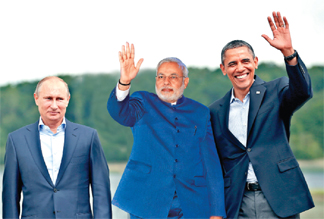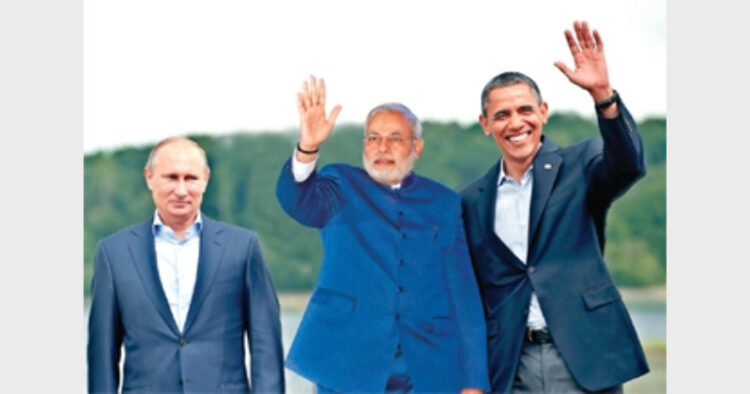 Intro: Russia and the United States can be valued partners. It depends upon India how it can leverage both to meet its needs. ?
Intro: Russia and the United States can be valued partners. It depends upon India how it can leverage both to meet its needs. ?
President Putin had come and gone. President Obama is expected here as chief guest at the Republic Day celebrations. The emerging economic power, India, being strategically located has become a favoured choice for both Russia and US. Russia faces a compulsion in the global geopolitics after being expelled from G 8 over its action in annexing Crimea. Further the shooting down of the Malaysian airliner MH 17 allegedly by the rebels in eastern Ukraine further aggravated the situation with the Western bloc declaring sanctions against Russia. Though the situation does not seems to be an absolute return to the cold war era, but can be viewed as a step towards a soft realignment in the geopolitics.
The moot issue here is where and how much India stands to gain? India has already said that it cannot be a party to any sanctions against Russia.
The US has already expressed its intention to act as a “pivot” and “rebalance” in Asia-Pacific. With the plan to position itself in the region, the US faces increasingly assertive role of China. Therefore, partnership with India has become a necessity for America.
Defence is one of the most critical areas where India seeks cooperation from these two global powers. Manufacture of defence equipments in the country through co-design, co-production and transfer of technology is what the Indian Prime Minister Narendrai Modi seeks under his ambitious “Make in India” programme.
With a number of acquisitions in the pipeline, the US is likely to become a top supplier of defence products to India, displacing Russia. However, Prime Minister Modi has clarified saying: “Even as India”s options have increased today, Russia will remain our most important defence partner. We have conducted joint exercises across all three wings of the Armed Forces in the last six months.”
Even today 60 per cent to 70 per cent of India”s defence platforms are from Russia. It is the first country to come for co-production and co-development of defence products with India.
Recently Russia has entered into a military pact with Pakistan for the first time to exchange views and information on politico-military issues as well as issues related to strengthening of mutual trust and international security. It has, however, clarified that this is not directed against India, but to empower Pakistan to deal with the terrorists in Afghanistan.
India-US Defence Trade and Technology Initiative (DTTI) was inked two years ago when the UPA government led by Dr Manmohan Singh was in power. It was the initiative of the then US Defence Secretary Leon E Panetta that was subsequently shephered by the then US Defence Secretary Ash Carter. The DTTI has on its agenda proposals for co-production and co-development. Though the new framework for the US-India defence relationship has been extended to next 10 years beyond July 2015 during the recent visit of US Defence Secretary Chuck Hagel to India, the net results of actual cooperation is yet to be seen on the ground.
One need to understand what US really means by technology transfer. Ash Carter had earlier spelt it out by saying: “We”ve adapted our system in ways that will speed our release process for India..Especially in the Department of Defence, recognising that for all partners this process is subject to case-by-case review and there will always be some technologies that we will keep to ourselves.” This shows that US will not be liberal in technology transfer. However for funding of innovative projects, Carter had said: ‘We’ll ensure that those innovative projects receive priority funding. This is an approach we’ve only ever taken with the United Kingdom and Australia and now India will join that company.’
Another aspect that draws US closer to India in defence cooperation is the growing Indian market. Since 2008, over $9 billion in defence contracts have been signed between US and India compared with less than $500 million for all the years before.
During Prime Minister Modi”s recent talks with President Obama in Washington it was agreed to reinvigorate the political-military dialogue between the two countries and expand its role to serve as a wider dialogue on export licencing, defence and strategic cooperation.
It has been decided to set up a Task Force to expeditiously evaluate and decide on unique projects and technologies aimed at enhancing India’s defence industry and military capabilities. US agreed to cooperate in setting up of National Defence University in India. Both the US and India agreed to upgrade the existing bilateral Malabar naval exercise. Expressing concern over the rise of China in Asia-Pacific, both India and the US, agreed to work closely with countries in the region through consultations, dialogues and joint exercises. India-Japan-US trilateral will also be raised to the level of foreign ministers.
However, playing to Prime Minister Modi’s homeland security concerns, President Obama pledged to help India counter the threat of improvised explosive devices with information and technology. India on the other hand has shown eagerness to purchase US-made mine-resistant ambush-protected vehicles. India and US would co-produce and co-develop the next generation Javelin anti-tank missile. According to Hagel ‘This is an unprecedented offer that we have made only to India and no one else.’ Javelin is a man-portable, fire-and forgets, anti-tank missile employed by dismounted infantry to defeat current and future threat armoured combat vehicles. While for the Javelin project US will partner only with India, there are several defence projects US has with other countries, particularly with Australia-a strategic country in the Indo-Pacific region and with UK.
During President Putin”s recent visit, Russia has, however, agreed to fully manufacture one of its most advanced helicopters in India which includes the possibility of exports from India. The helicopter is both for civilian and military use. India and Russia will increase collaboration in joint design, development, manufacturing and marketing of technology-driven products. The two countries have already moved to a phase of joint design and development of defence systems.
In the areas of energy security, India and Russia signed a Strategic Vision for Strengthening Cooperation in Peaceful Uses of Atomic Energy that stipulates carrying forward the Kudankulam Nuclear Power Projects by setting up 10 more nuclear reactors and manufacture of equipment and components in India. Australia has already agreed to supply uranium to India to be used as feedstocks.
India stands much to gain by effecting a free trade agreement with the proposed Eurasian Union and after the proposed International North-South Transport Corridor is operationalised. Indian investors see greenfield opportunities in Russia”s hydrocarbons and natural resources. Possibilities of a gas pipeline from Russia to India can be explored. Prime Minister Modi has appealed to Russia to make direct sale of rough diamonds to India. India can thus become a hub for diamond polishing and exports.
Russia faces militancy and terrorism in Chechnya and India has similar problems from across the border. This brings the two countries closer in fight against terrorism.
Ashok B Sharma ?(The writer is a senior columnist)?














Comments